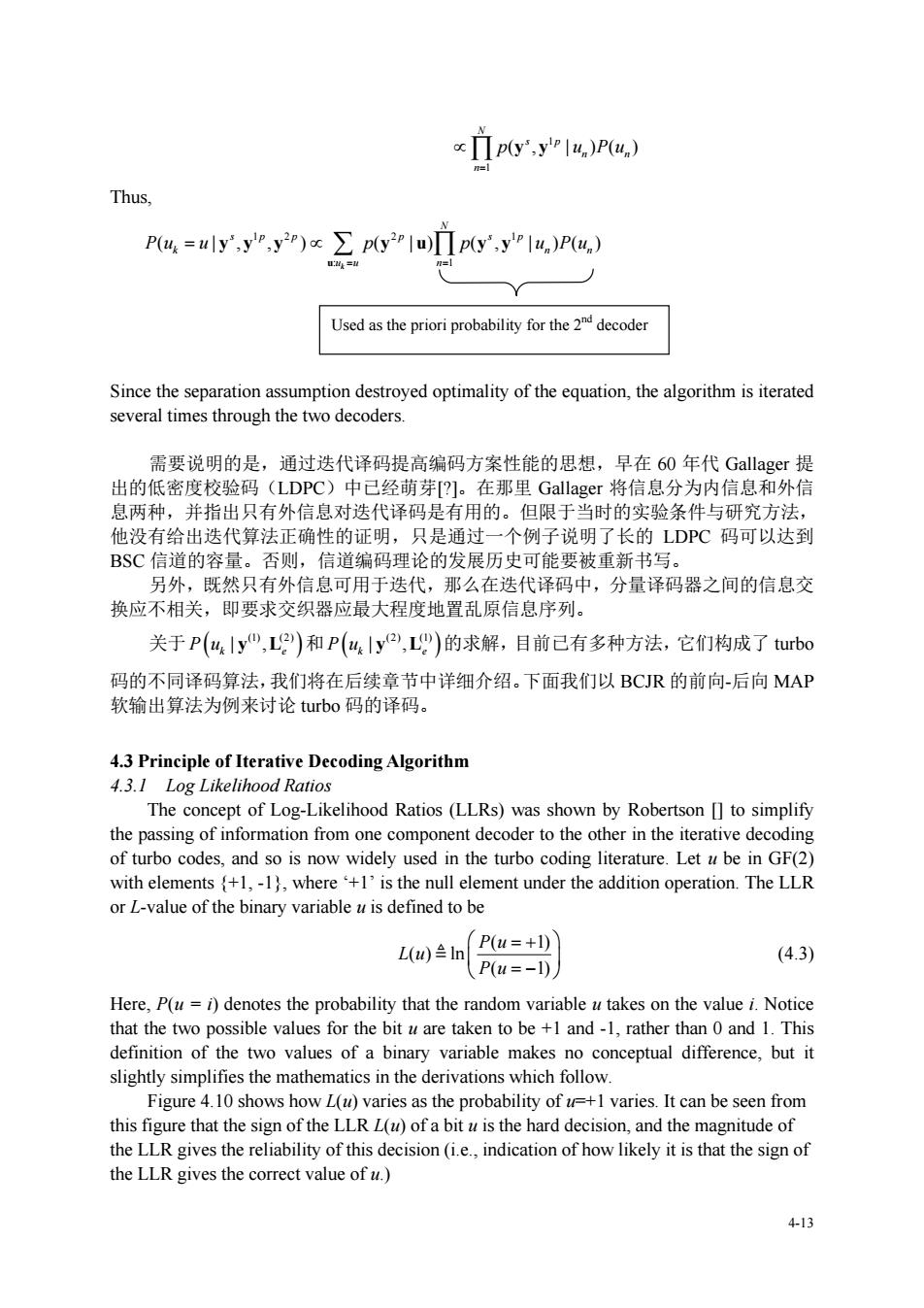正在加载图片...

p(y'.ylu)P(u) Thus, P4=,y)xpwIp,yIP) Used as the priori probability for thedecoder Since the separation assumption destroyed optimality of the equation,the algorithm is iterated several times through the two decoders 需要说明的是,通过迭代译码提高编码方案性能的思想,早在60年代Gallager提 出的低密度校验码(LDPC)中己经萌芽]。在那里Gallager将信息分为内信息和外信 息两种,并指出只有外信息对迭代译码是有用的。但限于当时的实验条件与研究方法, 他没有给出迭代算法正确性的证明,只是通过一个例子说明了长的LDC码可以达到 BSC信道的容量。否则,信道编码理论的发展历史可能要被重新书写。 另外,既然只 有外信息可用于迭代,那么在迭代译码中,分量译码器之间的信息交 换应不相关,即要求交织器应最大程度地置乱原信息序列。 关于P(u,y",L2)和P(w,ly,)的求解,目前已有多种方法,它们构成了tubo 码的不同译码算法,我们将在后续章节中详细介绍。下面我们以BCJR的前向-后向MAP 软输出算法为例来讨论turbo码的译码。 4.3 Principle of Iterative Decoding Algorithm 4.3.1 Log Likelihood Ratios The concept of Log-Likelihood Ratios(LLRs)was shown by Robertson [to simplify the passing of information from one component decoder to the other in the iterative decoding of turbo codes,and so is now widely used in the turbo coding literature.Let be in GF(2) null e ement under the addition operation.The LLR oan别 (4.3) Here.P(denotes the probability that the random variable takeson the value Notice that the two possible values for the bit uare taken to be+1 and-1,rather than 0 and 1.This definition of the two values of a binary variable makes no conceptual difference,but it slightly simplifies the mathematics in the derivations which follow. Figure 4.10 shows how L(u)varies as the probability of =+1 varies.It can be seen from this figure that the sign of the LLRL()ofa bit is the hard decision,and the magnitude of the LLR gives the reliability of this decision(of how likely it is that the sign of the LLR gives the correct value of u.) 413 4-13 1 1 ( , | )( ) N s p n n n p u Pu y y Thus, 12 2 1 : 1 ( | , , ) ( |) ( , | )( ) k N sp p p sp k n n u u n Pu u p p u Pu u yy y y u yy Since the separation assumption destroyed optimality of the equation, the algorithm is iterated several times through the two decoders. 需要说明的是,通过迭代译码提高编码方案性能的思想,早在 60 年代 Gallager 提 出的低密度校验码(LDPC)中已经萌芽[?]。在那里 Gallager 将信息分为内信息和外信 息两种,并指出只有外信息对迭代译码是有用的。但限于当时的实验条件与研究方法, 他没有给出迭代算法正确性的证明,只是通过一个例子说明了长的 LDPC 码可以达到 BSC 信道的容量。否则,信道编码理论的发展历史可能要被重新书写。 另外,既然只有外信息可用于迭代,那么在迭代译码中,分量译码器之间的信息交 换应不相关,即要求交织器应最大程度地置乱原信息序列。 关于 (1) (2) | , P uk e y L 和 (2) (1) | , P uk e y L 的求解,目前已有多种方法,它们构成了 turbo 码的不同译码算法,我们将在后续章节中详细介绍。下面我们以 BCJR 的前向-后向 MAP 软输出算法为例来讨论 turbo 码的译码。 4.3 Principle of Iterative Decoding Algorithm 4.3.1 Log Likelihood Ratios The concept of Log-Likelihood Ratios (LLRs) was shown by Robertson [] to simplify the passing of information from one component decoder to the other in the iterative decoding of turbo codes, and so is now widely used in the turbo coding literature. Let u be in GF(2) with elements {+1, -1}, where ‘+1’ is the null element under the addition operation. The LLR or L-value of the binary variable u is defined to be ( 1) ( ) ln ( 1) P u L u P u (4.3) Here, P(u = i) denotes the probability that the random variable u takes on the value i. Notice that the two possible values for the bit u are taken to be +1 and -1, rather than 0 and 1. This definition of the two values of a binary variable makes no conceptual difference, but it slightly simplifies the mathematics in the derivations which follow. Figure 4.10 shows how L(u) varies as the probability of u=+1 varies. It can be seen from this figure that the sign of the LLR L(u) of a bit u is the hard decision, and the magnitude of the LLR gives the reliability of this decision (i.e., indication of how likely it is that the sign of the LLR gives the correct value of u.) Used as the priori probability for the 2nd decoder